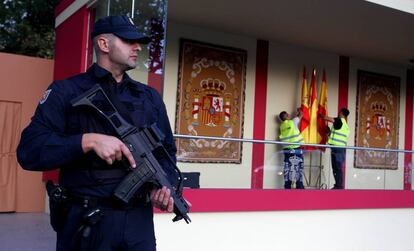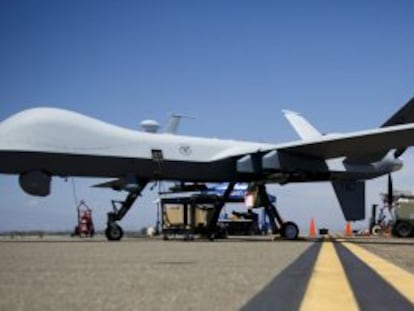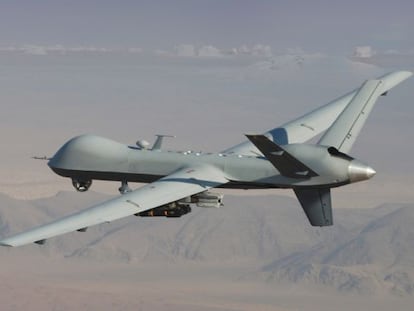Spain’s armed forces feel the pain of government spending cuts
Absence of a government over the last 12 months has further delayed budget decisions

As Spain holds its annual military parade to celebrate the October 12 National Holiday, the country’s defense chiefs will be concerned about the prospect of further cuts to the armed forces’ budgets, as well as the impact of a 10-month political impasse that has left the country without a government.
A year ago, looking for ways to further cut spending, the Spanish government decided to ground the first of the armed forces’ four Boeing 707 spy planes, dubbed the Queen of the Spectrum. On September 27 of this year, the last was retired. Returning them to the air is a priority, but is unlikely to happen any time soon.
The Spanish navy retired its Principe de Asturias aircraft carrier in 2013
Such aircraft have played a key role in recent wars: before any aerial bombardment, an electronic attack is unleashed to disrupt the enemy’s communications and radar, dismantling its command and control network and blinding its air defense system, allowing combat planes and bombers to do their job with near impunity.
Spain decided to provide itself capable of engaging in electronic warfare in 1991, when the Socialist Party administration of then-Prime Minister Felipe González gave the green light to the top secret Santiago Program. The jewel in the crown of the system, which includes naval and land bases, was the Boeing 707, bought second hand for the equivalent of €500,000 and then refitted in Israel over the next three years with cutting-edge electronic technology. Over the next decade, it was Spain’s ear on the world, collecting intelligence and updating electromagnetic maps where Spanish forces might eventually be deployed. But, unable to update its ageing systems, a year ago, the government retired it.
In the meantime, Spain has had to make do with pods attached to its fleet of F-18 fighters, but as the experts have warned, these planes lack the reach and self-sufficiency of the B-707.
Spain’s Defense Ministry says that recovering its ability to wage electronic warfare is a priority, and plans to remodel a Falcon 900 transport plane with smaller, more efficient monitoring equipment than that used on the outdated B-707. Once the government gives the green light, it would take a year to refit a Falcon 900 and make it operative. In the meantime, the armed forces will have to make do and mend.
Spain’s Defense Ministry says that its ability to wage electronic warfare is a priority
Further cuts to the military budget now mean that Spain is no longer able to refuel its F-18s in the air, having also lost its T-17 tanker planes. This jeopardizes the country’s ability to take part in the US-led Red Flag maneuvers in the Nevada desert, because the F-18 needs refueling in mid-Atlantic. The air force was planning to lease three Airbus A-330 Multi Role Tanker Transports more than a year ago, but the political impasse of the last 10 months that has left Spain without a government has put that on hold.
The Spanish navy retired its Principe de Asturias aircraft carrier in 2013 after the government said it could not afford to maintain or modernize it. Instead, it now uses the Juan Carlos I multi-purpose amphibious assault ship, which has a ski-jump ramp, but nothing like the storage capacity of a full aircraft carrier. In 2020, the navy is set to retired its fleet of vertical take-off Harriers. The alternative is the F-35, but Spain did not take part in the initial phases of the project, and now cannot afford to buy them on the open market.
Meanwhile, problems with developing the S-80 submarine mean that the navy has had to continue operating its three S-70s. Spain’s state-owned Navantia shipbuilder says that after a redesign, the S-80 is now back on track. But it is not clear how many units will be built, or what each will cost, or whether their air-independent propulsion technology systems will be ready in time. The navy’s fleet of helicopters has lost its anti-submarine capacity and there is no longer a naval version of the NH-90, the Spanish-made helicopter designed to serve the army, air force, and navy.
English version by Nick Lyne.
Tu suscripción se está usando en otro dispositivo
¿Quieres añadir otro usuario a tu suscripción?
Si continúas leyendo en este dispositivo, no se podrá leer en el otro.
FlechaTu suscripción se está usando en otro dispositivo y solo puedes acceder a EL PAÍS desde un dispositivo a la vez.
Si quieres compartir tu cuenta, cambia tu suscripción a la modalidad Premium, así podrás añadir otro usuario. Cada uno accederá con su propia cuenta de email, lo que os permitirá personalizar vuestra experiencia en EL PAÍS.
¿Tienes una suscripción de empresa? Accede aquí para contratar más cuentas.
En el caso de no saber quién está usando tu cuenta, te recomendamos cambiar tu contraseña aquí.
Si decides continuar compartiendo tu cuenta, este mensaje se mostrará en tu dispositivo y en el de la otra persona que está usando tu cuenta de forma indefinida, afectando a tu experiencia de lectura. Puedes consultar aquí los términos y condiciones de la suscripción digital.











































